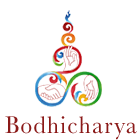Path of Heroes
The Path of Heroes is a profound and all-inclusive Lojong commentary by Shechen Gyaltsap Rinpoche, and the root text for Tara Rokpa training. Rinpoche was requested to give a reading transmission (lung) on this great text. During the transmission he also gave these two talks at Bodhicharya Berlin and on Zoom. In addition, included here as part 2 is a short Q&A session after the lung was completed.
The transmission was requested and arranged by Tara Rokpa and Bodhicharya Berlin.
Photos thanks to Ger Reinders.
A SUMMARY
by Maggy Jones
Part 1
Rinpoche talks briefly about Shechen Gyaltsab Rinpoche with whom he took vows as a child. He reminisces about his aunt going on pilgrimage to Lhasa. More reminiscences about monastic education in Sikkim and the role of Shechen Gyaltsab R. He was asked to write complete instructions and commentary on Lojong and the 7 Points of Mind Training; this became the Path of Heroes. Rinpoche learned lessons his work at the University! Everything, anything can be a lesson e.g. appreciating different views. Tarthang Tulku divided the text into sections with explanations for self or group study. Tarthang Tulku now lives in America and is very involved with translations, books and publishing. Q & A
* Path of Heroes. Dharma Publishing, U.S. (1995) ISBN 978-0898002737
Includes instructions on 4 Thoughts, Ngöndro, 7 Points of Mind Training, Tonglen.
For details of these please see https://rigpawiki.org
Part 2
Brief Q & A session. (Questions inaudible) The whole session is very light-hearted.) Comments on how a translation can miss important subtleties. (“Bodhicharyavatara” has been translated into Chinese.) How he taught Bodhicharyavatara to Rigpa centres as a “serial”, continuing from where he had stopped at each new centre. (The recordings are in the archives). Light-hearted chit-chat.
Part 3
More Q & A. Q What are Pratyeka Buddhas? R. Buddha talked about 3 types of people who will find realisation in different ways. 1st Shravakayana people who want to work in a group. 2nd Pratyeka Buddha type people are very intelligent “loners” but do not want to “follow”. 3rd Bodhisattva type people who work for the benefit of all people and aspire to be Buddhas.
Q. Purification practices. R. The strongest is to see the true nature of things. Story of repentance of Ajatasattu (spelling ?). 2nd is to practice with full power – body, speech, and mind, realising your errors, 3rd regret and do something positive; and 4th vow not to do them again.
Q. What is mind? Where is this “me”? It is unborn and unceasing. Appreciation of this develops your compassion as “me” becomes less strong. Welcome bad treatment because this helps you to develop. Story of Zen monk who paid someone to insult him.
Q. What happens to mind when you die? What is “Atma”? Is it Hindu or Buddhist?
Q. “Idiot” compassion; compassion is never “idiot” but some people are. Q. What is the connection with the paramitas and compassion? Q. If you have precepts and break them does this have a stronger karmic affect? Do not get yourself out of proportion.
For more information, visit: https://www.bodhicharya.de







